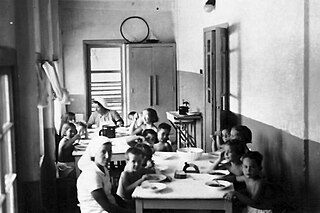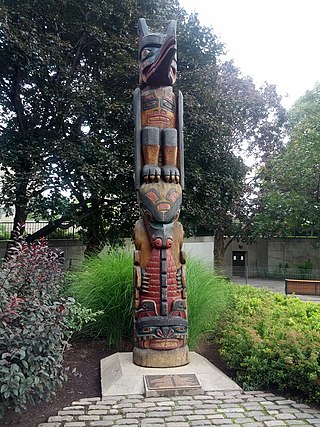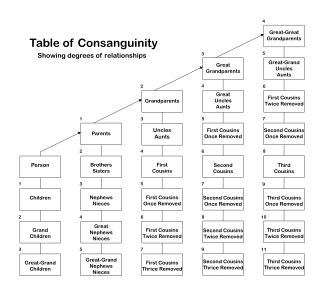
Cultural anthropology is a branch of anthropology focused on the study of cultural variation among humans. It is in contrast to social anthropology, which perceives cultural variation as a subset of a posited anthropological constant. The term sociocultural anthropology includes both cultural and social anthropology traditions.
Incest is human sexual activity between family members or close relatives. This typically includes sexual activity between people in consanguinity, and sometimes those related by lineage. It is forbidden and considered immoral in most societies, and can lead to an increased risk of genetic disorders in children in case of pregnancy.

The Westermarck effect, also known as reverse sexual imprinting, is a psychological hypothesis that states that people tend not to be attracted to peers with whom they lived like siblings before the age of six. This hypothesis was first proposed by Finnish anthropologist Edvard Westermarck in his book The History of Human Marriage (1891) as one explanation for the incest taboo.
Exogamy is the social norm of mating or marrying outside one's social group. The group defines the scope and extent of exogamy, and the rules and enforcement mechanisms that ensure its continuity. One form of exogamy is dual exogamy, in which two groups continually intermarry with each other.

In anthropology, kinship is the web of social relationships that form an important part of the lives of all humans in all societies, although its exact meanings even within this discipline are often debated. Anthropologist Robin Fox says that the study of kinship is the study of what humans do with these basic facts of life – mating, gestation, parenthood, socialization, siblingship etc. Human society is unique, he argues, in that we are "working with the same raw material as exists in the animal world, but [we] can conceptualize and categorize it to serve social ends." These social ends include the socialization of children and the formation of basic economic, political and religious groups.

A totem is a spirit being, sacred object, or symbol that serves as an emblem of a group of people, such as a family, clan, lineage, or tribe, such as in the Anishinaabe clan system.

Consanguinity is the characteristic of having a kinship with a relative who is descended from a common ancestor.
In cultural anthropology, reciprocity refers to the non-market exchange of goods or labour ranging from direct barter to forms of gift exchange where a return is eventually expected as in the exchange of birthday gifts. It is thus distinct from the true gift, where no return is expected.
In discussing consanguineal kinship in anthropology, a parallel cousin or ortho-cousin is a cousin from a parent's same-sex sibling, while a cross-cousin is from a parent's opposite-sex sibling. Thus, a parallel cousin is the child of the father's brother or of the mother's sister, while a cross-cousin is the child of the mother's brother or of the father's sister. Where there are unilineal descent groups in a society, one's parallel cousins on one or both sides will belong to one's own descent group, while cross-cousins will not.
Structural anthropology is a school of sociocultural anthropology based on Claude Lévi-Strauss' 1949 idea that immutable deep structures exist in all cultures, and consequently, that all cultural practices have homologous counterparts in other cultures, essentially that all cultures are equatable.
The avunculate, sometimes called avunculism or avuncularism, is any social institution where a special relationship exists between an uncle and his sisters' children. This relationship can be formal or informal, depending on the society. Early anthropological research focused on the association between the avunculate and matrilineal descent, while later research has expanded to consider the avunculate in general society.

Totem and Taboo: Resemblances Between the Mental Lives of Savages and Neurotics, or Totem and Taboo: Some Points of Agreement between the Mental Lives of Savages and Neurotics, is a 1913 book by Sigmund Freud, the founder of psychoanalysis, in which the author applies his work to the fields of archaeology, anthropology, and the study of religion. It is a collection of four essays inspired by the work of Wilhelm Wundt and Carl Jung and first published in the journal Imago (1912–13): "The Horror of Incest", "Taboo and Emotional Ambivalence", "Animism, Magic and the Omnipotence of Thoughts", and "The Return of Totemism in Childhood".
In law and in cultural anthropology, affinity is the kinship relationship created or that exists between two people as a result of someone's marriage. It is the relationship each party in the marriage has to the family of the other party in the marriage. It does not cover the marital relationship itself. Laws, traditions and customs relating to affinity vary considerably, sometimes ceasing with the death of one of the marriage partners through whom affinity is traced, and sometimes with the divorce of the marriage partners. In addition to kinship by marriage, "affinity" can sometimes also include kinship by adoption or a step relationship.
A cousin marriage is a marriage where the spouses are cousins. The practice was common in earlier times and continues to be common in some societies today, though in some jurisdictions such marriages are prohibited. Worldwide, more than 10% of marriages are between first or second cousins. Cousin marriage is an important topic in anthropology and alliance theory.
Alliance theory, also known as the general theory of exchanges, is a structuralist method of studying kinship relations. It finds its origins in Claude Lévi-Strauss's Elementary Structures of Kinship (1949) and is in opposition to the functionalist theory of Radcliffe-Brown. Alliance theory has oriented most anthropological French works until the 1980s; its influences were felt in various fields, including psychoanalysis, philosophy and political philosophy.
The exchange of women is an element of alliance theory — the structuralist theory of Claude Lévi-Strauss and other anthropologists who see society as based upon the patriarchal treatment of women as property, being given to other men to cement alliances. Such formal exchange may be seen in the ceremony of the traditional Christian wedding, in which the bride is given to the groom by her father.

Claude Lévi-Strauss was a French anthropologist and ethnologist whose work was key in the development of the theories of structuralism and structural anthropology. He held the chair of Social Anthropology at the Collège de France between 1959 and 1982, was elected a member of the Académie française in 1973 and was a member of the School for Advanced Studies in the Social Sciences in Paris. He received numerous honours from universities and institutions throughout the world.
Variations in the number of lexical categories across the languages is a notable idea in cultural anthropology. A former study on "color terms" explores such variations. Brent Berlin and Paul Kay (1969) argued that these qualitative and quantitative differences can be organized into a coherent hierarchy. As far as kinship terms are concerned, the variation is not found as an hierarchical organization, but as a result of conditions or constraints. That is to say, the number of kinship terms varies across the languages because of sociocultural conditions or constraints on the biological traits.
The Traffic in Women: Notes on the "Political Economy" of Sex is an article regarding theories of the oppression of women originally published in 1975 by feminist anthropologist Gayle Rubin. In the article, Rubin argued against the Marxist conceptions of women's oppression—specifically the concept of "patriarchy"—in favor of her own concept of the "sex/gender" system. It was by arguing that women's oppression could not be explained by capitalism alone as well as being an early article to stress the distinction between biological sex and gender that Rubin's work helped to develop women's and gender studies as independent fields. The framework of the article was also important in that it opened up the possibility of researching the change in meaning of this categories over historical time. Rubin used a combination of kinship theories from Lévi-Strauss, psycho-analytic theory from Freud, and critiques of structuralism by Lacan to make her case that it was at moments where women were exchanged that bodies were engendered and became women. Rubin's article has been republished numerous times since its debut in 1975, and it has remained a key piece of feminist anthropological theory and a foundational work in gender studies.
Blood Relations: Menstruation and the Origins of Culture is a book by the evolutionary anthropologist Chris Knight. Published by Yale University Press in hardback 1991 and in paperback four years later, it has remained in print ever since.







